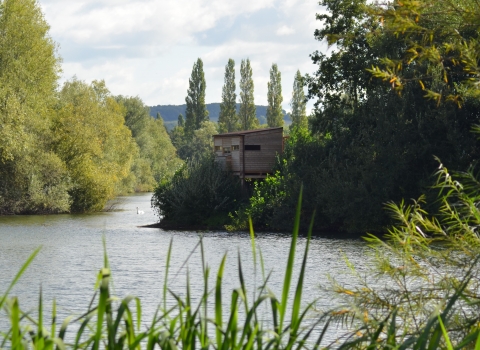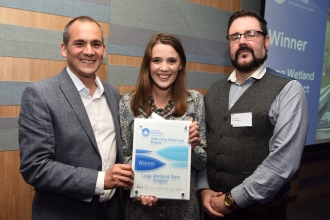Bodenham Lake: Lugg Wetland Gem - delivering the nutrient management plan
In 2018, Herefordshire Wildlife Trust secured funding from the National Lottery Heritage Fund and European Regional Development Fund for our project at Bodenham Lake nature reserve.
Bodenham Lake has long been a favourite amongst wildlife lovers and this project created a true wildlife haven at this reserve in the heart of the Lugg Valley. Over two years, the project focused on key aspects of restoration as well as providing more facilities for wildlife watchers of all ages.
Bodenham Lake, formed by the extraction of gravel, is the largest water body in Herefordshire. It is crucial for breeding otter and wildfowl. However, the value of Bodenham Lake as a nature reserve is limited by the habitat; aquatic vegetation grows in very small quantities as the Lake is steep sided and extremely deep. The project addressed this in a number of ways.

Re-profiling the lake
In 2018 we moved thousands of tonnes of soil to re-profile three steep sided areas of the lake, creating one hectare of shallower banks. In May 2019 we planted 1,600 reed plants (phragmites) in the re-profile areas to create a reedbed, a nationally scarce habitat which supports a wealth of wildlife including many iconic wetland species such as bearded tits, bitterns and reed warblers.
Installing a nesting platform
Osprey are seen passing over Bodenham Lake as part of their migration every year. There are only 200-250 breeding pairs in the UK, most of which are in Scotland. The combination of the close proximity or the River Lugg and the density of Lakes makes the floodplain of the River Lugg ideal for Osprey. We hope that by installing an osprey platform, passing ospreys will be encouraged to stay and nest.
Before reprofiling...
After reprofiling...
Bird Hides
In addition to the existing bird hide, we have installed a new bird hide, donated by the Herefordshire Ornithological Club, on the other side of the lake. This enables people to see and enjoy the new habitats created and the species they attract first-hand. The public can also learn about the wildlife of the Lugg Valley through new interpretation and signage around the site and in the bird hide.
For Families & Schools
For younger visitors, a new pond-dipping pool and platform were created at the reserve which will be available for families and schools to explore pond life at close quarters!
We ran wetland habitat-themed educational sessions linked to the national curriculum for KS1 – KS2. Sessions included pond dipping and other practical, wildlife focused activities. Our Teachers Pack included seasonal activities to do at the lake, advice on the creation of wetland habitats in school grounds and advice on long term management.
Schools should contact us at enquiries@herefordshirewt.co.uk for more information.
Wildlife Surveys
Local volunteer groups were trained in surveying skills to enable them to survey and monitor the species in and around the lake.
Events
We want people to be at the heart of our heritage conservation activities and there will be events happening throughout the project for people to find out more about how the project is progressing and enjoy this beautiful site.
A public launch of the project will be held during summer 2017, throughout the project we will run guided walks and in summer 2018 a celebration event.
Please check our Events pages and Facebook page for up to date information.
Transforming the lake's islands
In autumn and winter 2020, we completed work to three of the islands within the lake to make them better for wildlife, working with JPR Environmental. Large, new areas of shallows created as well as a vertical sandy bank suitable for nesting sand martin and kingfishers.
We were awarded £84,164 of European Regional Development Funding towards this and have raised an additional £8,000 through generous donations from our supporters so we can achieve even more for Bodenham's wildlife!
The first stage of the works was to remove trees from the islands to allow earth works to take place. The islands have not been managed since they were formed in the 1980s resulting in dense cover of willow and alder and sparse ground cover for nesting birds and otter. This is how we altered the islands:
- Island 1: Win spoil from the bottom section of the island and add it to the old road that runs underwater to create shallow waters suitable for aquatic plants and wading birds.
- Island 2: Create three islands of a larger surface area. Two of these islands will be below the water level to allow reedbed to establish. The remaining island will be allowed to scrub up, to provide cover for otter.
- Island 3: A trench will be dug through the centre of the island to win spoil to create three islands with a larger surface area. These islands will be capped with gravel to create habitat suitable for ground nesting birds. Island 3 is in front of the new bird hide.
What are the benefits to wildlife?
Islands are vital for nesting birds, as they provide increased levels of protection from land-based predators, improving survival of chicks. Bodenham Lake has five islands equating to 1.75 hectares, providing fantastic potential to conserve species such as oystercatcher and snipe (which are are on the RSPB Amber list as they have experienced a moderate decline of 25-50% in UK breeding population over last 25 years).
Since gravel extraction finished in the 1980’s there has been little ecological management of the islands, allowing them to form immature woodland which is suitable for very few ground nesting bird species; they require good visibility to spot aerial and aquatic predators approaching the nest.
The aim of the re-profiling work is to increase habitat diversity, to support a wider range of species. Removing trees from two and a half out of the five islands will encourage birds such as little ringed plover, oystercatcher, lapwing and snipe to nest, helping to conserve these species. Research by the RSPB has shown that several small islands will hold more nesting birds than a single island of the same total area, so we plan to transform three islands into eight.
The remaining two and a half islands will remain unchanged to support populations such as herons, cormorants and greylag geese.


